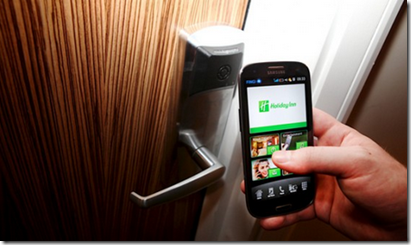NFC or Near Field Communication is the big buzz word at the moment and everybody is talking about it. The truth is that the technology is nothing new and it has been around for a long time. Nokia had an NFC enabled phone in 2007, it was called the Nokia 6131.
Google has made the term mainstream with their announcement of Google Wallet and most people think of NFC as a way to pay with their mobile device. But that is not all.
So what else can you do with NFC apart from using it for payments? There are already plenty of examples out there. Below you can find 6 examples on how NFC can be used right now.
1. Use your NFC enabled phone as the key to your hotel room

For the recent Olympics in London a Holiday Inn Hotel gave their VIP customers a Samsung Galaxy S3 as part of their 40 VIP rooms. The guests were able to check in and out of the hotel, as well as change the AC, control the TV, and unlock their rooms with the phone.
Using NFC in your phone as a key to open doors has been used in the Enterprise world as well. The phones were used to enable physical access systems in buildings and track employee time-clock check-ins and attendance, access staff parking areas or cafeterias and pay for services.
NFC tags could be placed inside meeting or conference rooms, and attendees could tap their compatible devices to silence them or to turn on Wi-Fi, for example.
2. Use it as your travel pass
NFC in your phone could replace the paper train or bus passes that we carry around with us. The principal would be very similar to the Oyster card in London, but it would be on your phone. You can easily recharge it when it runs low and you always have it with you.

The City of Nice has already started to roll out NFC based bus and train tickets as well as the possibility to get information on routes and time tables, simple by tapping an NFC tag
3. Use it as a way finder
GPS is great, but it has one major drawback and that is that is doesn’t work indoors.
NFC tags placed all around a shopping mall could simply be tapped and would open a map that accurately pinpoints where you are at the moment because it knows where the tag was tapped.

The city of Sydney has placed NFC tags all around the Rocks to help guide tourists around one of its most popular landmark.
4. Use it to enhance your shopping experience
NFC tags placed next to items in a shopping environment can give the customer more information, nutritional or general, it could let them like a product or add it to their virtual basket. It could give them specials or coupons for direct redemption in store etc.

NFC mobile application could remember your previous purchases allowing you to make a purchase in the convenience of your home.
There have been successful pilot programs being conducted in several countries such as France, Spain, UK, Australia and Korea. Major retailers have adopted NFC to improve sales conversion, up-selling, loyalty programs, couponing etc.
5. Easy device to device sharing
Remember setting up a Bluetooth connection between phones or trying to send a large video file via email?
NFC makes that a thing of the past and sharing files between NFC enabled devices is like a walk in the park now.
Check out Android Beam in action below.
Manufacturers like Samsung went ahead and optimized the technology even further and their S Beam is one of the main features of the new Samsung Galaxy SIII.
6. NFC and marketing
When you ask why QR codes never really took off, the answer could be that you still had to have a separate app on your phone to read one of those. If the phones native camera would have been able to decode them I believe they would have been very popular.
NFC in NFC enabled phones is native and comes out of the box and all you have to do is tap the tag and the information gets transferred.

Users with NFC phones can quickly wave their devices over NFC-enabled flyers, advertisements, billboards or movie posters to instantly collect additional information on products or service, collect awards, get brochures or movie trailers.
NFC is evolving on a daily basis and we can see prototypes and pilot programs everywhere:
The University of San Francisco is currently using an NFC-based system called One Card
Alaska Airlines is experimenting with NFC for boarding passes and security access.
Samsung is working on a system that will let concert goers access shows and events using NFC instead of traditional paper tickets.
BMW has built an NFC-enabled car key that can not only unlock an automobile, but also eventually help you book and access hotels room while you’re traveling.
Source: http://amnesiablog.wordpress.com/2012/08/16/nfc-is-not-just-mobile-payment/#more-6517
